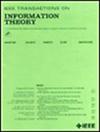The Guesswork of Ordered Statistics Decoding: Guesswork Complexity and Decoder Design
IF 2.2
3区 计算机科学
Q3 COMPUTER SCIENCE, INFORMATION SYSTEMS
引用次数: 0
Abstract
This paper investigates guesswork over ordered statistics and formulates the achievable guesswork complexity of ordered statistics decoding (OSD) in binary additive white Gaussian noise (AWGN) channels. The achievable guesswork complexity is defined as the number of test error patterns (TEPs) processed by OSD immediately upon finding the correct codeword estimate. The paper first develops a new upper bound for guesswork over independent sequences by partitioning them into Hamming shells and applying Hölder’s inequality. This upper bound is then extended to ordered statistics, by constructing the conditionally independent sequences within the ordered statistics sequences. Next, we apply these bounds to characterize the statistical moments of the OSD guesswork complexity. We show that the achievable guesswork complexity of OSD at maximum decoding order can be accurately approximated by the modified Bessel function, which increases exponentially with code dimension. We also identify a guesswork complexity saturation threshold, where increasing the OSD decoding order beyond this threshold improves error performance without further raising the achievable guesswork complexity. Finally, the paper presents insights on applying these findings to enhance the design of OSD decoders.有序统计译码的猜测:猜测复杂性与译码器设计
研究了有序统计解码的猜测复杂度,给出了二元加性高斯白噪声信道下有序统计解码可实现的猜测复杂度。可实现的猜测复杂度定义为OSD在找到正确码字估计后立即处理的测试错误模式(TEPs)的数量。本文首先利用Hölder不等式,将独立序列划分为汉明壳层,给出了一个新的猜测上界。然后,通过在有序统计序列内构造条件无关序列,将该上界扩展到有序统计。接下来,我们应用这些边界来描述OSD猜测复杂度的统计矩。结果表明,改进的贝塞尔函数可以精确地逼近OSD在最大解码阶下的可实现猜测复杂度,该复杂度随码维数呈指数增长。我们还确定了一个猜测复杂度饱和阈值,在此阈值之上增加OSD解码顺序可以改善错误性能,而不会进一步提高可实现的猜测复杂度。最后,本文提出了应用这些发现来增强OSD解码器设计的见解。
本文章由计算机程序翻译,如有差异,请以英文原文为准。
求助全文
约1分钟内获得全文
求助全文
来源期刊

IEEE Transactions on Information Theory
工程技术-工程:电子与电气
CiteScore
5.70
自引率
20.00%
发文量
514
审稿时长
12 months
期刊介绍:
The IEEE Transactions on Information Theory is a journal that publishes theoretical and experimental papers concerned with the transmission, processing, and utilization of information. The boundaries of acceptable subject matter are intentionally not sharply delimited. Rather, it is hoped that as the focus of research activity changes, a flexible policy will permit this Transactions to follow suit. Current appropriate topics are best reflected by recent Tables of Contents; they are summarized in the titles of editorial areas that appear on the inside front cover.
 求助内容:
求助内容: 应助结果提醒方式:
应助结果提醒方式:


